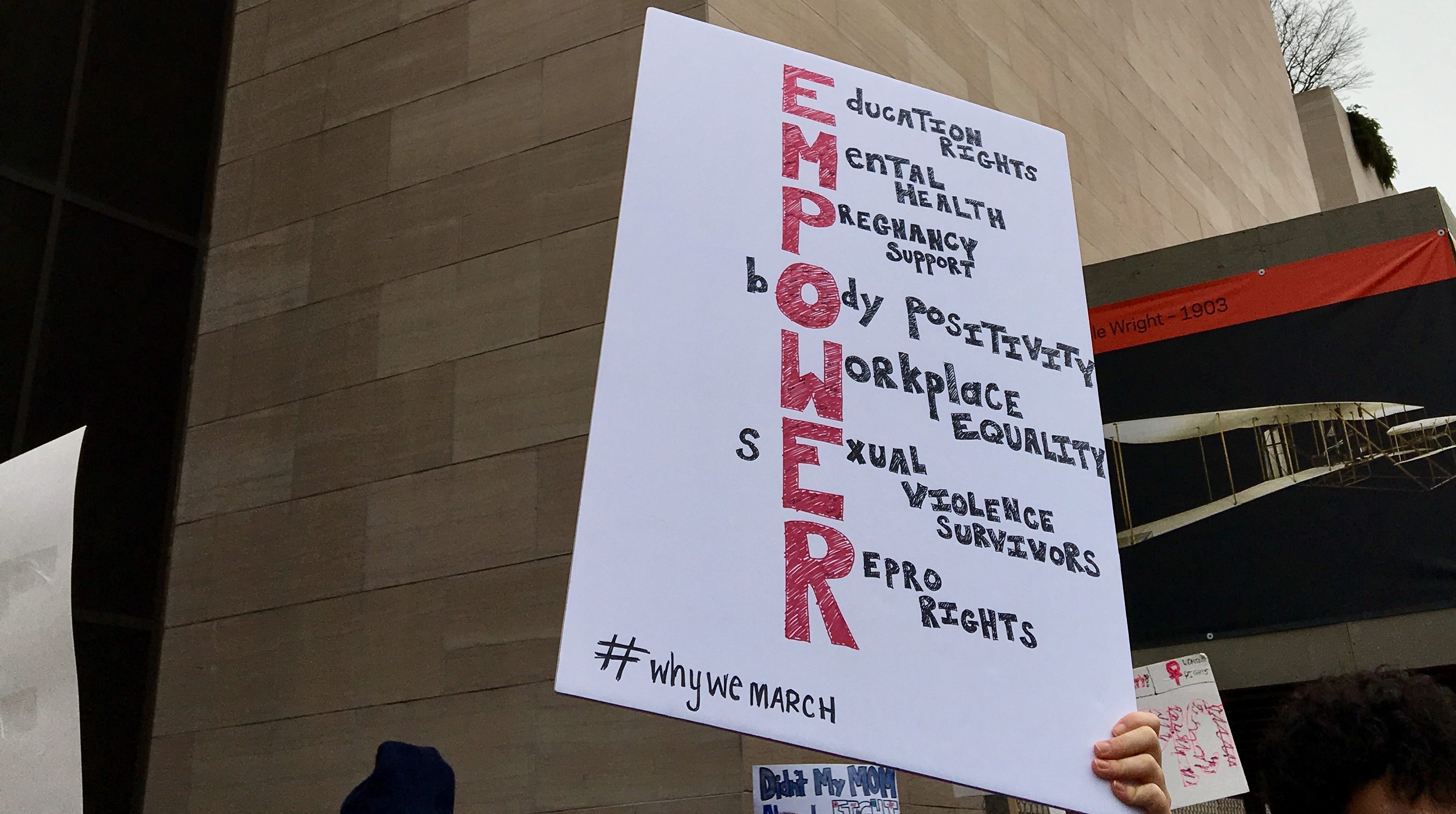What does it mean to be a feminist in the age of Trump?
Discussions around this question have been percolating since Donald Trump won enough electoral votes to defeat the only woman to ever run as major-party candidate for the presidency of the United States. But they came into sharp focus on January 21, when nearly half a million women descended on Washington, D.C. At the center of this debate is the question of how crucial abortion rights are to a modern feminist agenda. For many feminists, young and old, the two are inseparable. But a smaller contingent of pro-lifers—that is, women who do not support abortion ethically and/or legally—seized upon the popularity of the Women’s March to call this assumption into question.
Their presence, though small compared to the enormity of the march, didn’t come without its share of controversy. Just days prior, march organizers had officially disavowed one of its partners—the Texas-based group known as New Wave Feminists—after an Atlantic article detailed the goals of the pro-life contingent. Although the march had some 400 or so registered partners—including numerous pro-choice groups, such as Planned Parenthood, NARAL, and even some religious organizations, like Catholics for Choice—the backlash was swift and unrelenting. “Horrified that the @womensmarch has partnered w/an anti-choice org,” wrote Jessica Valenti, a Guardian columnist, on Twitter. “Plse reconsider — inclusivity is not about bolstering those who harm us.” Amanda Marcotte, another prominent feminist writer and Salon columnist, opined: “Nope, you cannot be anti-choice and feminist. Forcing birth on unwilling women is a misogynist act.”
Within hours, organizers had scrubbed New Wave Feminists from their roster of partners. “The anti-choice organization in question is not a partner of the Women’s March on Washington,” noted organizers in a statement released on January 16. “We apologize for this error.”
But neither New Wave Feminists nor their like-minded compatriots were ready to give up. Some, like Kristen Day of Democrats for Life, saw it as an opportunity. “Once they said that pro-life women weren’t welcome and couldn’t sponsor the event, that’s what said ‘we need to be there,’” she told me in an interview. Life Matters Journal president Aimee Murphy echoed a similar sentiment in a Washington Post op-ed published on January 18, where she proclaimed the staff at the journal had no intention of changing their original plans. “We will go. We will march,” she wrote. “Planned Parenthood does not own women’s rights.”
Destiny Herndon-De La Rosa, head of New Wave Feminists, was quick to note that she saw where the organizers were coming from, even if she found their decision disappointing. “Being pro-life and a feminist, I’m used to pretty much every group we’re part of saying that we don’t belong,” she told me the day after the march. “I understand. Having backlash and having trolls attack you, and the pressure of that—they’re trying to organize a march.”
“We’re willing to put aside our differences with this march to come together on things that we do agree on.”
“So when they removed us, it was understandable,” she continued. “I definitely got it. I assume they had no idea it would become such a point of controversy.”
And, really, New Wave Feminists took it in stride—humor, Herndon-De La Rosa emphasized, was crucial to their strategy. Shortly after the Women’s March released its official statement, New Wave Feminists fired back with a meme: “World: You can’t be feminist and be pro-life. Pro-Life Feminists: Hold my beer.”
Even by 10 a.m. on the morning of the march, it was easy to get lost in the sea of bodies flooding Independence Avenue. Still, despite all their earlier controversy, the pro-lifers were proudly conspicuous on the steps of the Smithsonian Air and Space Museum. A giant teal sign proclaiming “Stop Killing Human Beings”—which was followed by a laundry list of foreign and domestic policies viewed as antithetical to a pro-life agenda—stood tall among the rally-goers standing on the museum’s steps. Hailing from anywhere from Texas to Pennsylvania, they had descended on Washington the day after the inauguration to join forces with some half-million other participants from across the political spectrum to send a message that, as Hillary Clinton had said before a United Nations conference on women in 1995, “women’s rights are human rights.” Many were set to return for the March for Life next week. Few fit the stereotypical image of pro-lifers: most were young, many were non-religious, and nearly all framed their arguments against abortion in secular, not spiritual, terms.
The overwhelming feeling at the march was one of accomplishment—a drastic shift from the funereal atmosphere that enveloped D.C., or at least its Trump-supporter-free zones, the day prior. The crowds were huge and exponentially larger than expected—merely shifting one’s weight required at least several of the people surrounding you to change their position as well.
The wound left by the kerfuffle earlier in the week remained a bit raw. A few attendees told me that, while they’re pleased to be in a country where such a march can happen, they were disappointed the organizers were so quick to concede on abortion issues. Even though abortion rights were but one of many demands listed in the march’s unity principles, there was a sense that the organizers had placed an undue amount of attention on the subject. Indeed, as several attendees were quick to note, the march’s call for “open access to safe, legal, affordable abortion . . . for all people, regardless of income, location or education” was a late addition.
But, as several participants informed me, what mattered more was the considerable common ground shared between the pro-life contingent and the rest of the Women’s March. Indeed, as some argued, the march would have been strengthened if it appealed to a more “diverse crowd.”
“We want to be heard,” Christina Healy, a medical student, told me. “We’re willing to put aside our differences with this march to come together on things that we do agree on.”
For many attendees—several of whom described themselves as anywhere on the spectrum from “leftist” to “liberal”—disagreement on one major issue (abortion) while minor quibbles on others (e.g., whether certain forms of contraception, such as the morning-after pill and some forms of hormonal contraceptives, were viable and necessary alternatives) wasn’t enough to keep them away. Attendees called for a “big tent” approach to women’s rights—and in some cases, to resistance against Trump. Making room for pro-life feminists, in other words, meant making room for multiple interpretations of how feminism is defined.
“We just want to apply human rights to everyone—not just men, not just women, but to children at all stages of life, including after conception.”
The basis for negotiating a pro-life feminist ethic existed long before the march on Washington. It also underscores the methodology through which many pro-lifers critique Trump’s anti-abortion credentials. Many referenced the need for a “consistent life ethic” or “consistent ethic of life”—a term coined by Joseph Cardinal Bernardin in 1983 to describe a pro-life ethic that takes into account “concern for the broader attitude in society about respect for human life.” Or, as Rosemary Geraghty, social media coordinator for Life Matters Journal, defined it: “We just want to apply human rights to everyone—not just men, not just women, but to children at all stages of life, including after conception.”
How a consistent life ethic is interpreted on the level of policy varies—not all of its adherents are bleeding-heart liberals. Geraghty and others cited it as not only aligning with the progressive vision set out by march organizers, but also deviating from the dehumanizing rhetoric embraced by Trump during his campaign. The same unhinged misogynistic rhetoric that brought hundreds of thousands of pro-choice marchers to the streets that day had riled the pro-life community as well. But some of their suspicions ran deeper: in addition to questioning the president’s stated opposition to abortion and to Planned Parenthood, attendees pressed that his anti-immigration platform, his proclivity for threatening to use nukes, and—above all—his aggressive stance against the Affordable Care Act all flew in the face of any consistent life ethic. Merely doing away with abortion wasn’t enough; these policy points were about encouraging a broader politics of life.
For those pro-lifers seeking to find broader points of cooperation with their pro-choice comrades in the age of Trump, recent legislation may pose yet another hurdle. Trump’s reinstatement of the Mexico City Policy, which prohibits the U.S. government from providing funding to groups that “actively promote abortion,” as well as the House’s passage of HR-7, which would prevent multi-state health insurance plans from covering the procedure, have drawn the ire of progressive feminists. But some, such as Democrats for Life’s Kristen Day, see these policies as a victory.
Others noted that overt legal restrictions weren’t their foremost goal—changing the culture was. “We don’t work to make abortion illegal—we work to make it unthinkable,” Herndon-De La Rosa stressed. “Laws follow culture, not the other way around. If we create laws and the culture hasn’t changed, all it’s going to do is make criminals out of women.”
That said, few of the solutions offered by pro-life groups to assuage fears about the broader range of services that would be lost were Planned Parenthood to be defunded are likely to build many bridges. Herndon-De La Rosa, who notes that she wouldn’t be upset were Planned Parenthood to be defunded, cites Federally Qualified Health Centers (FQHCs) as a possible replacement. Like Planned Parenthood, FQHCs offer a range of services, including covering reproductive health, and operate on a sliding pay scale. Unlike Planned Parenthood, FQHCs are barred from providing abortions. Yet with FQHCs being chronically underfunded, not to mention the fact that in some cases reproductive health services weren’t billed on a sliding scale, it does raise the question: Would they even be viable for most low-income women?
As the crowd moved sluggishly from the Air and Space Museum toward the White House, these tensions began to come to the fore. Geraghty, clutching a megaphone, began to chant, “Pro-choice, that’s a lie, babies never choose to die!” A sea of counter responses—including chants like “my body, my choice”—immediately rushed in. If a detente was meant to be, now wasn’t the time.
Hannah Gais is associate digital editor at The Washington Spectator.







The “Big Tent” is the way to go with respect to any movement, but permitting the participation of those that want to bring the tent down is suicidal, a big mistake. The pro-life ladies that wanted to march should have been permitted to march IF they had poster demanding more funds for child-welfare, for women’s healthcare and rights. But, it seems they were just there to voice their misguided pro-birth rhetoric: they are not pro-life.
There are few statements about individual human actions that can be confidently made, but one is, “No woman ever woke up and said to herself ‘I think I’ll get pregnant so I can have an abortion.'”
Abortion is a bad solution to a worse problem.
If we really want to lower the number of abortions to a minimum number and keep it there, we should be providing better alternatives that address the underlying problems: valuing women so that when a woman says “No'” her decision is respected and followed. Providing universal prenatal and well-baby care. Enforcing child-support payment obligations. A minimum wage that allows a full-time worker to raise a child. Adequately enforcing restraining orders. Enforcing child-support payment obligations. Putting rapists out of circulation quickly, and for very long periods of time. And the list goes on.
“Pussy Hats” by the vulgar radical feminist gang must be repudiated. Warped, sick men might think it an invitation for sex. Maybe they are. Might just as well knit male Pecker Sleeves.
When I was asked by a reporter for TheBlaze what I thought of the lack representation of the Pro-Life movement at the #WomensMarch in Washington, DC, I said that the Pro-Life Movement did not need representation because a “woman’s’ right to not have an abortion is not threatened in this new administration ” this was paraphrased in the article here: https://bit.ly/jwdwdc